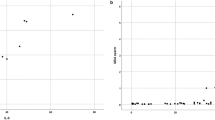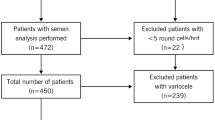Abstract
Purpose
To evaluate the role of pathogens and moderate leukocytes on seminal interleukin (IL)-6, IL-8, and sperm parameters in men undergoing infertility investigation.
Methods
Semen samples from men (n = 171) were divided into three groups on the basis of leukocyte count: no leukocytes (L−; ≤0.1 × 106/ml Mio/ml), moderate leukocytes (L±; >0.1 × 106/ml and <1 × 106/ml), and high leukocytes (=leukocytospermia) (L+; ≥1 × 106/ml). Each group was further classified into two subgroups, according to the presence (B+) or absence (B−) of pathogens. IL-6, IL-8, and sperm characteristics were analyzed in each subgroup. A correlation test was performed to show the association between inflammatory parameters and sperm characteristics.
Results
No significant differences in leukocyte count, cytokine levels, and sperm characteristics were apparent in subgroups with and without pathogens. Grade b motility was significantly lower in subgroup IIa (L±,B−) than in subgroup Ia (L−,B−)(p < 0.05). More significant limitations in sperm motility (lower rapid progressive motility and increased percentage of immotile sperm) were observed in subgroup IIIa (L+,B−) compared with subgroup Ia (p < 0.05). Moderate and high leukocytes increased significantly cytokine levels (p < 0.001).
Conclusions
Moderate leukocyte counts could be an indicator of male genital tract inflammation. Seminal pathogens have no influence on cytokine levels and sperm parameters.
Similar content being viewed by others
References
Fraczek M, Kurpisz M (2007) Inflammatory mediators exert toxic effects of oxidative stress on human spermatozoa. J Androl 28:325–333
Comhaire FH, Mahmoud AM, Depuydt CE, Zalata AA, Christophe AB (1999) Mechanisms and effects of male genital tract infection on sperm quality and fertilizing potential: the andrologist’s viewpoint. Hum Reprod Update 5:393–398
Penna G, Mondaini N, Amuchastegui S et al (2007) Seminal plasma cytokines and chemokines in prostate inflammation: interleukin 8 as a predictive biomarker in chronic prostatitis/chronic pelvic pain syndrome and benign prostatic hyperplasia. Eur Urol 51:524–533
Wolff H (1995) The biologic significance of white blood cells in semen. Fertil Steril 63:1143–1157
Diemer T, Hales DB, Weidner W (2003) Immune-endocrine interactions and Leydig cell function: the role of cytokines. Andrologia 35:55–63
Rowe PJ, Comhaire FH, Hargreave TB, Mahmoud AMA (2000) WHO manual for the standardized investigation, diagnosis and management of the infertile male. Cambridge University Press, Cambridge
Kim FY, Goldstein M (1999) Antibacterial skin preparation decreases the incidence of false-positive semen culture results. J Urol 161:819–821
Cottell E, Harrison RF, McCaffrey M, Walsh T, Mallon E, Barry-Kinsella C (2000) Are seminal fluid microorganisms of significance or merely contaminants? Fertil Steril 74:465–470
Montagnini Spaine D, Mamizuka EM, Pereira Cedenho A, Srougi M (2000) Microbiologic aerobic studies on normal male urethra. Urology 56:207–210
Punab M, Lõivukene K, Kermes K, Mändar R (2003) The limit of leucocytospermia from the microbiological viewpoint. Andrologia 35:271–278
Lackner J, Schatzl G, Horvath S, Kratzik C, Marberger M (2006) Value of counting white blood cells (WBC) in semen samples to predict the presence of bacteria. Eur Urol 49:148–152
Gdoura R, Kchaou W, Znazen A, Chakroun N, Fourati M, Ammar-Keskes L, Hammami A (2008) Screening for bacterial pathogens in semen samples from infertile men with and without leukocytospermia. Andrologia 40:209–218
Sharma RK, Pasqualotto AE, Nelson DR, Thomas AJ Jr, Agarwal A (2001) Relationship between seminal white blood cell counts and oxidative stress in men treated at an infertility clinic. J Androl 22:575–583
Henkel R, Kierspel E, Stalf T, Mehnert C, Menkveld R, Tinneberg HR, Schill WB, Kruger TF (2005) Effect of reactive oxygen species produced by spermatozoa and leukocytes on sperm functions in non-leukocytospermic patients. Fertil Steril 83:635–642
World Health Organization (2010) WHO Laboratory manual for the examination and processing of human semen, 5th edn. World Health Organization, Geneva
Kruger TF, Franken DR, Menkveld R (1993) The self teaching programme for strict sperm morphology. MQ Medical, Bellville
Endtz AW (1972) A direct staining method for moist urinary sediment and moist human sperm. Ned Tijdschr Geneeskd 116:681–685 (in Dutch)
Rodin DM, Larone D, Goldstein M (2003) Relationship between semen cultures, leukospermia, and semen analysis in men undergoing fertility evaluation. Fertil Steril 3:1555–1558
Domes T, Lo KC, Grober ED, Mullen JB, Mazzulli T, Jarvi K (2012) The incidence and effect of bacteriospermia and elevated seminal leukocytes on semen parameters. Fertil Steril 97:1050–1055
Pannekoek Y, Trum JW, Bleker OP, van der Veen F, Spanjaard L, Dankert J (2000) Cytokine concentrations in seminal plasma from subfertile men are not indicative of the presence of Ureaplasma urealyticum or Mycoplasma hominis in the lower genital tract. J Med Microbiol 49:697–700
Eggert-Kruse W, Kiefer I, Beck C, Demirakca T, Strowitzki T (2007) Role for tumor necrosis factor alpha (TNF-alpha) and interleukin 1-beta (IL-1beta) determination in seminal plasma during infertility investigation. Fertil Steril 7:810–823
Martínez-Prado E, Camejo Bermúdez MI (2010) Expression of IL-6, IL-8, TNF-alpha, IL-10, HSP-60, anti-HSP-60 antibodies, and anti-sperm antibodies, in semen of men with leukocytes and/or bacteria. Am J Reprod Immunol 63:233–243
Aitken RJ, Baker HW (1995) Seminal leukocytes: passengers, terrorists or good samaritans? Hum Reprod 10:1736–1739
Ziyyat A, Barraud-Lange V, Sifer C, Ducot B, Wolf JP, Soufir JC (2008) Paradoxical increase of sperm motility and seminal carnitine associated with moderate leukocytospermia in infertile patients. Fertil Steril 90:2257–2263
Eggert-Kruse W, Pohl S, Näher H, Tilgen W, Runnebaum B (1992) Microbial colonization and sperm–mucus interaction: results in 1000 infertile couples. Hum Reprod 7:612–620
Knox CL, Allan JA, Allan JM, Edirisinghe WR, Stenzel D, Lawrence FA, Purdie DM, Timms P (2003) Ureaplasma parvum and Ureaplasma urealyticum are detected in semen after washing before assisted reproductive technology procedures. Fertil Steril 80:921–929
Kokab A, Akhondi MM, Sadeghi MR, Modarresi MH, Aarabi M, Jennings R, Pacey AA, Eley A (2010) Raised inflammatory markers in semen from men with asymptomatic chlamydial infection. J Androl 31:114–120
Conflict of interest
The authors declared no conflicts of interest.
Author information
Authors and Affiliations
Corresponding author
Rights and permissions
About this article
Cite this article
Aghazarian, A., Stancik, I., Pflüger, H. et al. Influence of pathogens and moderate leukocytes on seminal interleukin (IL)-6, IL-8, and sperm parameters. Int Urol Nephrol 45, 359–365 (2013). https://doi.org/10.1007/s11255-013-0400-8
Received:
Accepted:
Published:
Issue Date:
DOI: https://doi.org/10.1007/s11255-013-0400-8




